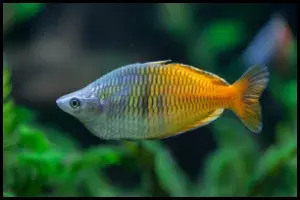
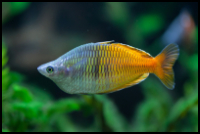
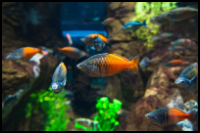

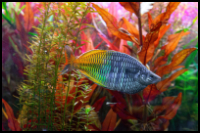
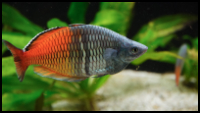
Quick Care Details (Table)
| Livestock Characteristics | Value |
|---|---|
| Care Level | Easy |
| Temperament | Peaceful |
| Diet | Omnivore |
| Maximum Size | 4 Inches |
| Minimum Tank Size | 30 Gallons |
| Plant Safe | Yes |
| Temperature Range | 72-78F |
| PH Range | 7.0-8.0 |
| KH Range | 9-19 |
Species Specific Categories
Helpful Video
Care Details
Aquascape: When setting up an aquarium for Boesemani Rainbow fish, it's best to replicate their natural habitat. These fish come from the clear, fast-flowing rivers of Indonesia and New Guinea. Create an environment with plenty of plants, driftwood, rocks, and some open spaces for swimming.
Substrate: For the substrate, opt for fine to medium-grained materials like sand or small pebbles. This resembles the riverbeds they call home in the wild.
Disease Prevention: To keep your Boesemani Rainbow fish healthy, maintain good water quality and conduct regular water changes. Quarantine new additions before introducing them to your main tank to prevent the spread of diseases.
Filtration: Efficient filtration is a must to keep the water clean and well-oxygenated. Canister or sponge filters work well for maintaining the water quality these fish prefer.
Lighting: Moderate lighting is sufficient. These fish are used to dappled light in their natural habitat due to the canopy of overhanging plants and trees.
Water Flow: Boesemani Rainbow fish appreciate a gentle to moderate water flow, much like what they experience in their river homes. Consider using a filter or powerhead to achieve this.
Hardiness: These fish are hardy and adaptable, provided water parameters stay within their preferred range. As long as conditions are stable, they tend to do well.
Acclimation: When introducing new Boesemani Rainbow fish to your tank, give them time to acclimate gradually to their new surroundings. This helps reduce stress during the transition.
Expected Lifespan: With the right care, Boesemani Rainbow fish can live for about 5-7 years. Consistency in their environment and diet is the key to their longevity.
Special Requirements: Boesemani Rainbow fish are shoaling species, so it's a good idea to keep them in groups of at least six to allow for their social behavior to flourish. They are omnivorous, so ensure a varied diet that includes high-quality flakes, pellets, frozen or live foods, and some plant matter.
Temperament and Behavior
Behavior: Boesemani Rainbow fish are known for their peaceful and friendly nature. They're typically active and enjoy exploring their environment. They exhibit fascinating social behavior within their group and often interact with one another. These fish are curious and may even investigate plants and decorations in the tank.
Breeding: Breeding Boesemani Rainbow fish can be a rewarding experience. To encourage breeding, provide a separate breeding tank with plenty of plants for the females to deposit their eggs. Males are known to display vibrant colors during courtship. After the eggs are laid, it's advisable to remove the adults to prevent them from consuming the eggs or fry.
Aggression: These fish are generally non-aggressive, but males can sometimes become territorial during the breeding season. Keeping them in groups helps distribute any aggression, and providing ample hiding spots can reduce conflicts.
Tankmates Compatibility: Boesemani Rainbow fish are compatible with a wide range of community fish. They coexist well with other non-aggressive species, including tetras, danios, gouramis, and peaceful catfish. Avoid aggressive or fin-nipping fish as tankmates.
Activity Level: Boesemani Rainbows are active swimmers and are known for their vibrant colors and graceful movements. They occupy various levels of the tank, from the bottom to the middle and upper regions, making them engaging to watch.
Schooling or Shoaling Behavior: These fish exhibit schooling behavior, so keeping them in a group of at least six or more is recommended. In a school, they display their most natural behaviors and vibrant colors. They feel more secure in the company of their own kind.
Plant Compatibility: Boesemani Rainbow fish tend not to uproot plants. In fact, they appreciate a well-planted aquarium, which provides hiding spots and mimics their natural habitat. However, avoid fragile or delicate plants, as their active swimming can dislodge them.
Diet and Nutrition
Dry Foods: Boesemani Rainbow fish are perfectly content with good-quality dry foods like flakes and pellets. You can make these a regular part of their diet. Just make sure the food is formulated for tropical or community fish.
Frozen Foods: To give them some variety and boost their coloration, consider adding frozen foods like brine shrimp, bloodworms, or daphnia to their diet. These are like tasty treats for them.
Live Foods: Boesemani Rainbow fish also relish live foods such as small insects, mosquito larvae, and daphnia. Including live foods now and then can mimic what they'd eat in the wild and keep them active and healthy.
Vegetables: While they're mainly meat-eaters, these fish won't say no to some veggies. You can offer blanched spinach, zucchini, or even algae wafers to ensure they get the fiber and nutrients they need.
Algae: Although they might nibble on algae in your tank, it's not their primary source of sustenance. You shouldn't rely solely on algae to meet their dietary requirements.
Feeding Schedule: Boesemani Rainbow fish prefer to eat several times a day but in smaller portions. This aligns with their natural feeding habits and helps them get the necessary nutrients without overloading your tank's water quality.
Supplemental Foods: In addition to their core diet of dry, frozen, and live foods, you can introduce some extra treats now and then, like freeze-dried brine shrimp or tubifex worms. These treats add some excitement to their diet.
Tank Parameters
Tank Size: To house a small group of Boesemani Rainbow fish comfortably, consider a tank that's around 30 gallons or more. However, if you plan to keep a larger group or include other fish species, it's a good idea to go for a bigger tank.
Tank Length and Measurements: For a 30-gallon tank, you'd want it to be at least 36 inches in length. This gives these active swimmers ample space to stretch their fins and roam about.
Water Temperature: Keep the water temperature in the range of 75-79°F. This creates a cozy tropical environment that these fish love. It's important to maintain a consistent temperature for their well-being.
pH (Acidity/Alkalinity): Boesemani Rainbow fish feel at home in water that's slightly acidic to neutral, with a pH level between 6.5 and 7.5. This mimics the conditions of their natural habitat.
KH (Carbonate Hardness) and GH (General Hardness): For stable water conditions that support their health and vibrant colors, aim for a KH level of 4-10 dKH and a GH level of 5-15 dGH.
Hardiness: These fish are known for their hardiness, which makes them a great choice for both novice and experienced aquarists. They adapt well to different water conditions.
Nitrate (NO3) Levels: To keep your Boesemani Rainbow fish healthy, it's important to maintain nitrate levels below 20 ppm. Regular water changes and efficient filtration are your allies in achieving this.
History, Popularity, History and Species Variety Details
The History, Popularity and Natural Habitat
The History: Boesemani Rainbow fish, also known by their scientific name Melanotaenia boesemani, were first stumbled upon in the 1980s, in the regions of West Papua, Indonesia. Interestingly, they owe their name to A. G. Boeseman, the Dutch ichthyologist who first collected them. These fish soon made their debut in the aquarium trade and quickly gained fame for their vibrant colors and charming behavior.
Popularity: These fish have earned a special place in the hearts of aquarium enthusiasts. Why, you ask? Well, their mesmerizing blend of blue, red, and yellow hues, not to mention their peaceful demeanor, has made them a real crowd-pleaser. They're often the go-to choice for community tanks because they get along well with a variety of other fish species.
Natural Habitat: In the wild, Boesemani Rainbow fish inhabit the clear, swift-flowing rivers and streams of West Papua, Indonesia. Picture this: crystal-clear waters surrounded by abundant greenery and an array of aquatic plants. These fish love to dart around among submerged branches and tree roots, seeking shelter and cozy spots for breeding. The dappled sunlight filtering through the rich aquatic plant life creates a picturesque setting for their daily adventures.
In essence, the history of Boesemani Rainbow fish traces back to their discovery in the enchanting waters of West Papua, Indonesia. Their eye-catching colors and easygoing nature have made them a top pick among fish enthusiasts. When recreating their natural habitat in our tanks, we aim to capture the essence of those clear, flowing waters and lush vegetation to ensure these captivating fish feel right at home.
Rainbow Fish Variations
- Turquoise Rainbow (Melanotaenia lacustris): These fish are famous for their beautiful turquoise-blue colors and share comparable care needs. They're peaceful community fish like the Boesemani.
- Celebes Rainbow (Marosatherina ladigesi): Hailing from Sulawesi, Indonesia, these Rainbows have a distinctive appearance with an elongated body and striking dorsal fin. They thrive in slightly acidic water and love well-planted tanks.
- Threadfin Rainbow (Iriatherina werneri): These slender and delicate Rainbows are smaller in size than Boesemani Rainbows. They stand out thanks to the thread-like extensions on their dorsal fins. They, too, prefer soft, slightly acidic water.
- Dwarf Neon Rainbow (Melanotaenia praecox): As their name suggests, these Rainbows are smaller than Boesemani and boast vivid neon colors. They're great for smaller aquariums and share similar water requirements.
- Australian Rainbow (Melanotaenia fluviatilis): Native to Australia, these fish are known for their lively coloration, resembling the Boesemani. They're adaptable and can coexist in a community tank with matching water conditions.
Great Tankmates For Your Rainbow Fish
- Gouramis: Peaceful gourami species like the Honey Gourami or Dwarf Gourami can coexist harmoniously with Boesemani Rainbows, as they share similar water parameter requirements.
- Tetras: Many tetra species, such as Neon Tetras, Cardinal Tetras, or Black Neon Tetras, make excellent tank mates due to their small size and peaceful nature.
- Corydoras Catfish: Corydoras catfish are ideal bottom-dwellers and are compatible with Boesemani Rainbows. Species like Bronze Corydoras are great choices.
- Rasboras: Rasboras, such as Harlequin Rasboras or Espe's Rasboras, are small and peaceful fish that coexist well with Boesemani Rainbows.
- Loaches: Peaceful loaches like the Yo-yo Loach or Clown Loach can share a tank with Boesemani Rainbows, but it's essential to provide ample hiding spots.
- Livebearers: Fish like Guppies or Swordtails are generally compatible and add a touch of color to the community tank.
- Amano Shrimp: These peaceful and efficient algae-eating shrimp make good tank mates for Boesemani Rainbows while helping to keep the tank clean.
- Snails: Peaceful snails, like Nerite Snails or Mystery Snails, serve as excellent tank cleaners and can coexist with Boesemani Rainbows.
- Dwarf Cichlids: Certain dwarf cichlid species like the German Blue Ram can be compatible with Boesemani Rainbows if the tank is spacious enough.
- Peaceful Barbs: Some barb species like Cherry Barbs or Gold Barbs can work well with Boesemani Rainbows in a community tank.
Frequently Asked Questions
What Tank Size is Suitable for Boesemani Rainbows?
30-gallon tank or larger is recommended, allowing these active swimmers plenty of room to thrive and display their natural behaviors.
Can Boesemani Rainbows Live with Other Fish?
Yes, they are known for their peaceful nature. They can coexist with a variety of other community fish species, but avoid aggressive tank mates.
What Do They Eat?
They are omnivores and accept a variety of foods, including high-quality flakes, live and frozen foods, and even vegetables.
Are They Suitable for Beginners?
Yes, their hardy nature and adaptability make them a great choice for both novice and experienced aquarists.
How Can I Enhance Their Colors?
Maintain a well-balanced diet, provide a clean and well-maintained aquarium, and ensure that the water parameters are within their preferred range to help enhance their colors.
Can Boesemani Rainbows Breed in Home Aquariums?
Yes, they are known to breed in aquariums. Provide them with a suitable breeding setup, including plants for egg-laying and a separate breeding tank for the fry.
How Many Boesemani Rainbows Should I Keep Together?
A group of at least six is recommended to ensure their well-being and allow them to exhibit their natural schooling behavior.
Can They Jump Out of the Tank?
Yes, they are known to be jumpers, so make sure to have a secure lid on your aquarium to prevent any escape attempts.
What's their Lifespan?
With proper care, they can live for 5-7 years or even longer.

